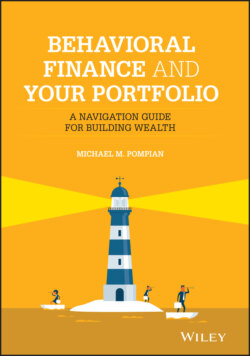Читать книгу Behavioral Finance and Your Portfolio - Michael M. Pompian - Страница 15
1 What Is Behavioral Finance and Why Does It Matter?
ОглавлениеPeople in standard finance are rational. People in behavioral finance are normal.
—Meir Statman, PhD, Santa Clara University
If you are reading this book, you have decided that building the best portfolio for you, your family or your organization requires a solid understanding of human behavior. And the most important human behavior to understand is your own! After all, you need to make the best financial decisions possible and this requires understanding how you behave when money is involved. After advising individuals and families for over 25 years on their investment portfolios, and now running my own investment firm, I have found that understanding and applying behavioral finance to the investment process is the absolutely best way to manage portfolios for long term financial success. It may be counter-intuitive, but unless one has super-human capabilities to know which direction the markets are going all the time, the best strategy for managing a portfolio is to choose a comfortable level of risk and stick with that strategy. The less tinkering the better! Does this mean you don't pay attention to it? Of course not! Investors need to pay attention to the value of assets they own, the structural changes in companies or industries that occur, portfolio rebalancing points, etc.—but the core asset allocation framework should remain the same unless personal circumstances have changed. So why is it so hard for investors to stay invested during periods of market volatility? Put simply, many people don't understand how emotions and irrational behaviors creep into the investment process. This book is all about understanding and diagnosing your own behavior so that you can create the best portfolios and have long-term investment success!
At its core, behavioral finance attempts to understand and explain actual investor and market behaviors versus theories of investor behavior. This idea differs from traditional (or standard) finance, which is based on assumptions of how investors and markets should behave. Investors from around the world who want to create better portfolios have begun to realize that they cannot rely solely on theories or mathematical models to explain individual investor and market behavior. As Professor Statman's quote puts it, standard finance people are modeled as “rational,” whereas behavioral finance people are modeled as “normal.” This can be interpreted to mean that “normal” people may behave irrationally—but the reality is that almost no one behaves perfectly rationally when it comes to finances and dealing with normal people is what this book is all about. We will delve into the topic of the irrational market behavior; however, the focus of the book is on individual investor behavior and how to create portfolios that investors can stick with for the long haul.
Fundamentally, behavioral finance is about understanding how people make decisions, both individually and collectively. By understanding how investors and markets behave, it may be possible to modify or adapt to these behaviors in order to improve economic outcomes. In many instances, knowledge of and integration of behavioral finance may lead to superior results for investors.
We will begin this chapter with a review of the prominent researchers in the field of behavioral finance. We will then review the debate between standard finance and behavioral finance. By doing so, we can establish a common understanding of what we mean when we say behavioral finance, which will in turn permit us to understand the use of this term as it applies directly to the practice of creating YOUR best portfolio.
